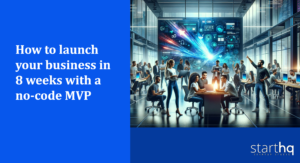This is part 1 of our 5 part blog series supporting our recent webinar "How…

Welcome to part 2 of our 5 part blog series supporting our recent webinar “How to launch your business in 8 weeks with a no-code MVP“. You can request a link to the webinar recording here.
So, you’ve got this brilliant idea for a tech startup and you’re ready to change the world. You have researched and validated your market (see part 1 of our series) but before you conquer your chosen industry, you need to make sure you’re on the right track. That’s where the Minimal Viable Product (MVP) comes in. It’s the ultimate test to validate your idea and get valuable feedback from your target customers.
But how do you go about building an MVP without blowing your budget on expensive traditional coding? Simple: embrace the magic of no-code development. In this article, we’ll discuss how to scope your MVP, what to focus on, how to get input from your target customers, options for building the MVP, and the benefits of no-code products over traditional coding when building it.
What’s an MVP Anyway?
An MVP is the most stripped-down version of your product that still provides value to your customers. It’s like a demo reel for your business idea, showing off the core features and benefits without all the bells and whistles. The goal is to test your concept, get feedback, and iterate as you go. If you do it right, you’ll save time, money, and energy while building a solid foundation for your startup.
Scoping Your MVP
First things first: scope your MVP. This step can make or break your project, so take the time to define what features are essential for your initial release. Ask yourself these questions:
- What is the core problem your product solves?
- What features are absolutely necessary for your target customers?
- What are your top priorities for functionality?
Focus on delivering just enough value to attract early adopters and test your assumptions. Leave out the nice-to-have features for now—you can always add them later as you learn more about your customers’ needs.
What to Focus On
When building your MVP, keep your eye on the prize. Concentrate on these key areas:
- User Experience: Your MVP should be easy to use and navigate. If your customers can’t figure out how to use your product, they won’t stick around for long.
- Feedback Mechanisms: Integrate ways for users to provide feedback directly within the MVP. This will help you understand what’s working and what needs improvement.
- Analytics: Track user behaviour and other important metrics to guide your decision-making process.
Remember, the goal of your MVP is to validate your idea and gather data—not to impress your customers with a fully polished product.
Getting Input from Target Customers
Once you’ve built your MVP, it’s time to get input from your target customers. Here are a few ways to gather feedback:
- User Interviews: Conduct one-on-one interviews with your early adopters to dive deep into their experiences. This is our preferred route, especially when building apps designed for B2B companies as the volume of users tends to be lower.
- Surveys: Send out surveys to collect quantitative data on your MVP.
- Beta Testing: Invite a select group of users to test your MVP and provide feedback.
The more input you gather, the better you’ll understand your customers’ needs and preferences. Use this feedback to make data-driven decisions as you iterate on your product.
Building Your MVP with No-Code Development
Now that you know what your MVP should look like, it’s time to build it, which is where no-code development comes in. Instead of hiring a team of developers and spending months (or years) coding from scratch, you can use no-code tools to create your MVP quickly and cost-effectively.
What is No-Code Development?
No-code development typically uses drag-and-drop interfaces and pre-built templates to create software without writing a single line of code. It’s like building with LEGO bricks—fast and flexible.
Benefits of No-Code Development for Startups
No-code development has a ton of benefits for startups, especially when it comes to building an MVP:
- Speed: You can build your MVP in a fraction of the time it would take using traditional coding methods.
- Cost: No-code tools are often more affordable than hiring a team of developers, making them perfect for bootstrapped startups.
- Flexibility: No-code platforms allow you to iterate quickly and easily, making changes on the fly based on user feedback.
- Accessibility: Even if you’re not a tech guru, you can use no-code tools to build your MVP. This levels the playing field for founders of all backgrounds.
However, there are a few scenarios where no-code tools may not be the best fit, for example:
- Complex business logic: bespoke coding can allow more control over logic and algorithms.
- Very high performance is required at the MVP stage: bespoke coding can give you more control over system resources.
- Your target market is highly regulated: no-code tools may not provide the security customisation required for certain industries, such as healthcare. If considering a no-code tool for a regulated industry, it is worth checking with the platform provider about support for any relevant regulations before you begin.
No-Code Development Agencies: Your MVP’s Secret Weapon
If you’re not sure where to start with no-code development, consider partnering with a no-code development agency (like us 😎). These experts can guide you through the process, helping you build a high-quality MVP that meets your goals and delights your customers.
A no-code development agency can help you:
- Choose the right tools: With so many no-code platforms out there, it can be overwhelming to choose the best one for your project. An agency can help you find the perfect fit.
- Design and build your MVP: Agencies have the experience and expertise to bring your vision to life, ensuring your MVP is both functional and visually appealing.
- Iterate based on feedback: As you gather input from your customers, your agency can help you make the necessary adjustments to improve your product.
Conclusion
Building an MVP is a crucial step in launching a successful startup. By using no-code development, you can create a cost-effective, efficient, and flexible MVP that allows you to test your idea and gather valuable feedback from your target customers.
So, what are you waiting for? Embrace the world of no-code development and start building your MVP today. Your future self (and your future customers) will thank you!


